CHEVROLET TRACKER 1997 Owners Manual
Manufacturer: CHEVROLET, Model Year: 1997, Model line: TRACKER, Model: CHEVROLET TRACKER 1997Pages: 388, PDF Size: 20.12 MB
Page 201 of 388
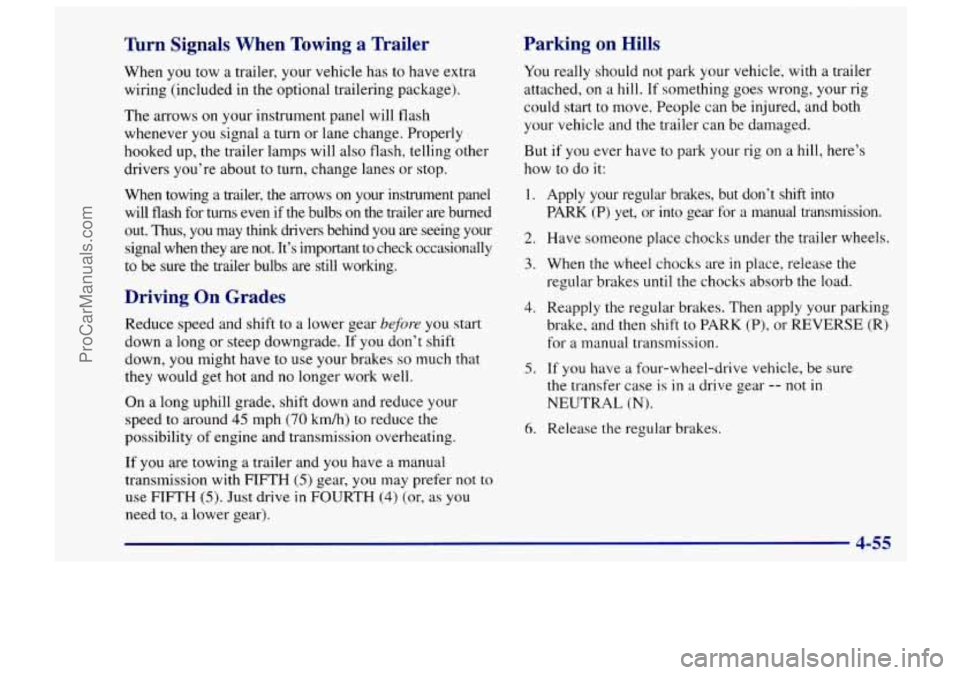
Turn Signals When Towing a Trailer
When you tow a trailer, your vehicle has to have extra
wiring (included in the optional trailering package).
The arrows on your instrument panel will flash
whenever you signal a turn or lane change. Properly
hooked up, the trailer lamps will also flash, telling other
drivers you’re about to turn, change lanes or stop.
When towing a trailer, the arrows on your instrument panel
will flash for turns even if
the bulbs on the trailer are burned
out. Thus, you may think drivers behind
you are seeing your
signal when they are not. It’s important to check occasionally
to be sure the trailer bulbs are still working.
Driving On Grades
Reduce speed and shift to a lower gear before you start
down a long or steep downgrade. If you don’t shift
down, you might have
to use your brakes so much that
they would get hot and no longer work well.
On a long uphill grade, shift down and reduce your
speed to around
45 mph (70 km/h) to reduce the
possibility of engine and transmission overheating.
If you are towing a trailer and
you have a manual
transmission with FIFTH
(5) gear, you may prefer not to
use FIFTH (5). Just drive in FOURTH (4) (or, as you
need to, a lower gear).
Parking on Hills
You really should not park your vehicle, with a trailer
attached, on a
hill. If something goes wrong, your rig
could start to move. People can be injured, and both
your vehicle and the trailer can
be damaged.
But
if you ever have to park your rig on a hill, here’s
how to do it:
1.
2.
3.
4.
5.
6.
Apply your regular brakes, but don’t shift into
PARK (P)
yet, or into gear for a manual transmission.
Have someone place chocks under the trailer wheels.
When the wheel chocks are
in place, release the
regular brakes until the chocks absorb the load.
Reapply the regular brakes.
Then apply your parking
brake, and then shift to
PARK (P), or REVERSE (R)
for a manual transmission.
If you have a four-wheel-drive vehicle, be sure
the transfer case
is in a drive gear -- not in
NEUTRAL (N).
Release the regular brakes.
4-55
I
ProCarManuals.com
Page 202 of 388
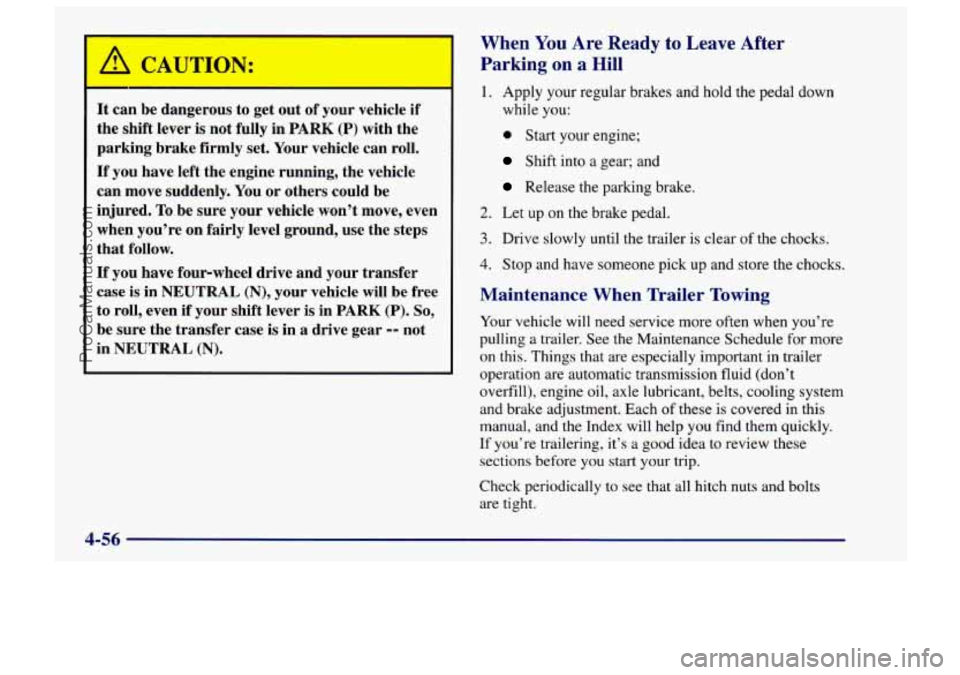
’ A CAUTION:
It can be dangerous to get out of your vehicle if
the shift lever is not fully in
PARK (P) with the
parking brake firmly set. Your vehicle can roll.
If you have left the engine running, the vehicle
can move suddenly. You or others could be
injured.
To be sure your vehicle won’t move, even
when you’re on fairly level ground, use the steps
that follow.
If you have four-wheel drive and your transfer
case
is in NEUTRAL (N), your vehicle will be free
to roll, even if your shift lever is in PARK (P). So,
be sure the transfer case is in a drive gear -- not
in
NEUTRAL (N).
When You Are Ready to Leave After
Parking
on a Hill
1. Apply your regular brakes and hold the pedal down
while you:
0 Start your engine;
Shift into a gear; and
Release the parking brake.
2. Let up on the brake pedal.
3. Drive slowly until the trailer is clear of the chocks.
4. Stop and have someone pick up and store the chocks.
Maintenance When Trailer Towing
Your vehicle will need service more often when you’re
pulling
a trailer. See the Maintenance Schedule for more
on this. Things that are especially important in trailer
operation are automatic transmission fluid (don’t
overfill), engine oil, axle lubricant, belts, cooling system
and brake adjustment. Each
of these is covered in this
manual, and the Index will help you find them quickly.
If you’re trailering, it’s
a good idea to review these
sections before you start your trip.
Check periodically to
see that all hitch nuts and bolts
are tight.
4-56
ProCarManuals.com
Page 203 of 388
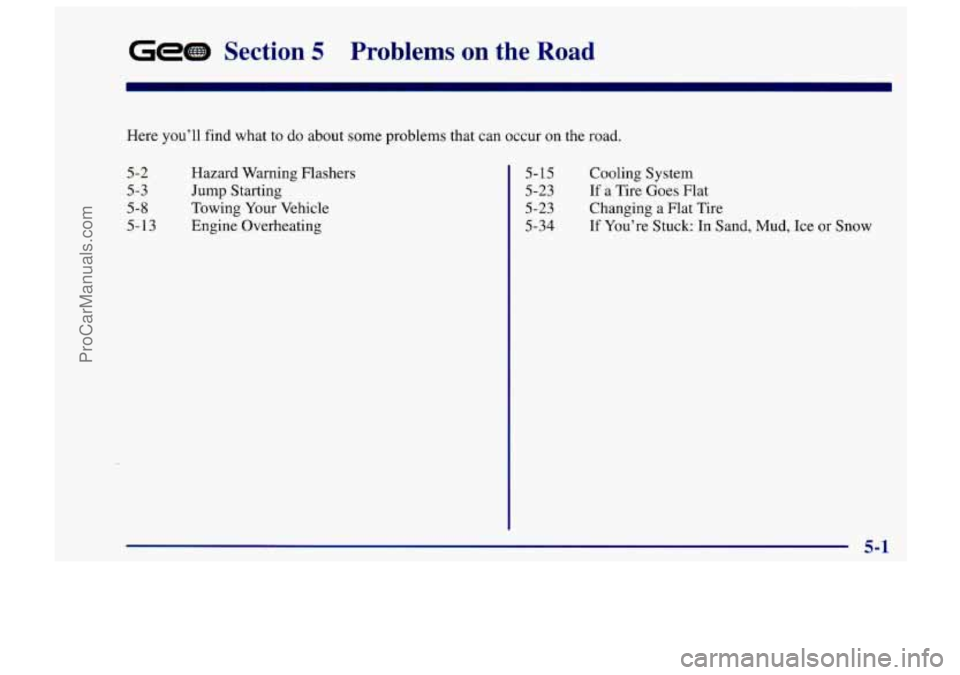
GEED Section 5 Problems on the Road
Here you’ll find what to do about some problems that can occur on the road.
5-2
5-3
5-8
5- 13 Hazard Warning
Flashers
Jump Starting
Towing Your Vehicle
Engine Overheating
5-15
5-23
5-23
5-34
Cooling System
If a Tire Goes Flat
Changing a Flat Tire
If You’re Stuck: In Sand, Mud, Ice or Snow
5-1
I
ProCarManuals.com
Page 204 of 388
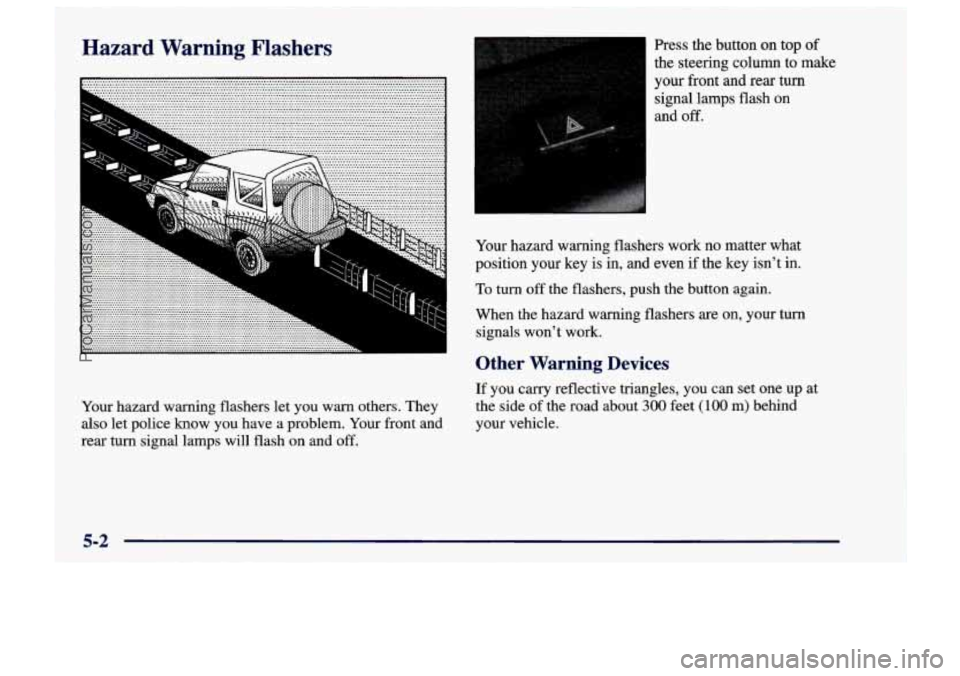
Hazard Warning Flashers Press the button on top of
the steering column to make
your front and rear turn signal lamps flash on
and
off.
Your hazard warning flashers work no matter what
position your key
is in, and even if the key isn’t in.
To turn off the flashers, push the button again.
When the hazard warning flashers
are on, your turn
signals won’t work.
Other Warning Devices
If you carry reflective triangles, you can set one up at
Your hazard warning flashers let you warn others. They the side
of the road about 300 feet (100 m) behind
also let police know you have a problem. Your front and your vehicle.
rear turn signal lamps will flash
on and off.
5-2
ProCarManuals.com
Page 205 of 388
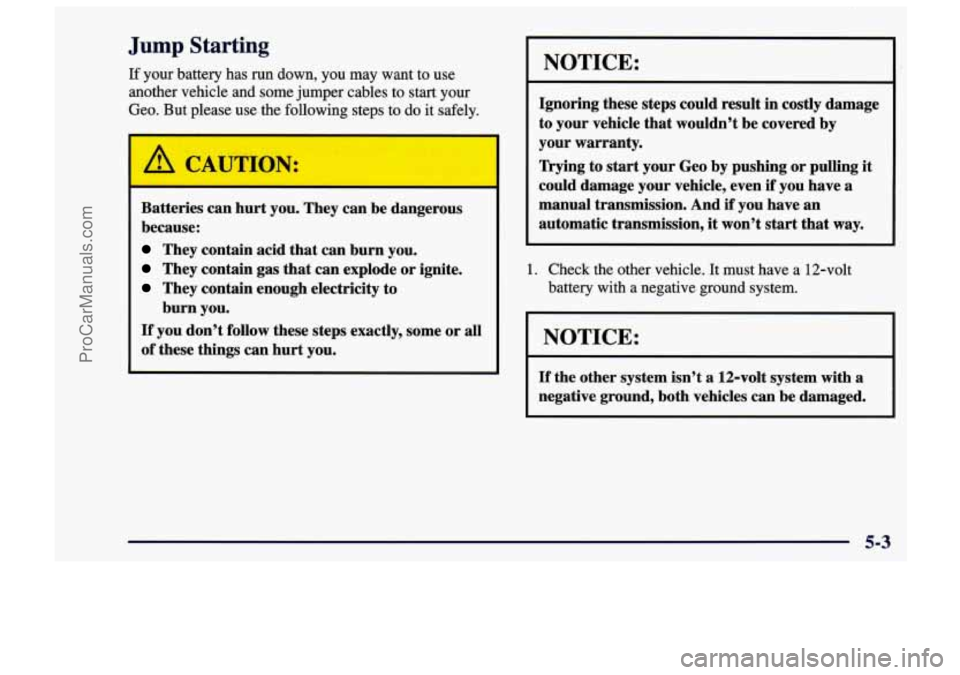
Jump Starting
If your battery has run down, you may want to use
another vehicle and some jumper cables to
start your
Geo. But please use the following steps to
do it safely.
’ A CAUTION:
Batteries can hurt you. They can be dangerous
because:
They contain acid that can burn you.
They contain gas that can explode or ignite.
They contain enough electricity to
If you don’t follow these steps exactly, some or all
of these things can hurt you.
burn
you.
NOTICE:
Ignoring these steps could result in costly damage
to your vehicle that wouldn’t be covered by
your warranty.
Trying
to start your Geo by pushing or pulling it
could damage your vehicle, even if you have a
manual transmission. And
if you have an
automatic transmission, it won’t start that way.
1. Check the other vehicle. It must have a 12-volt battery with a negative ground system.
I NOTICE:
If the other system isn’t a 12-volt system with a
negative ground, both vehicles can be damaged.
5-3
ProCarManuals.com
Page 206 of 388
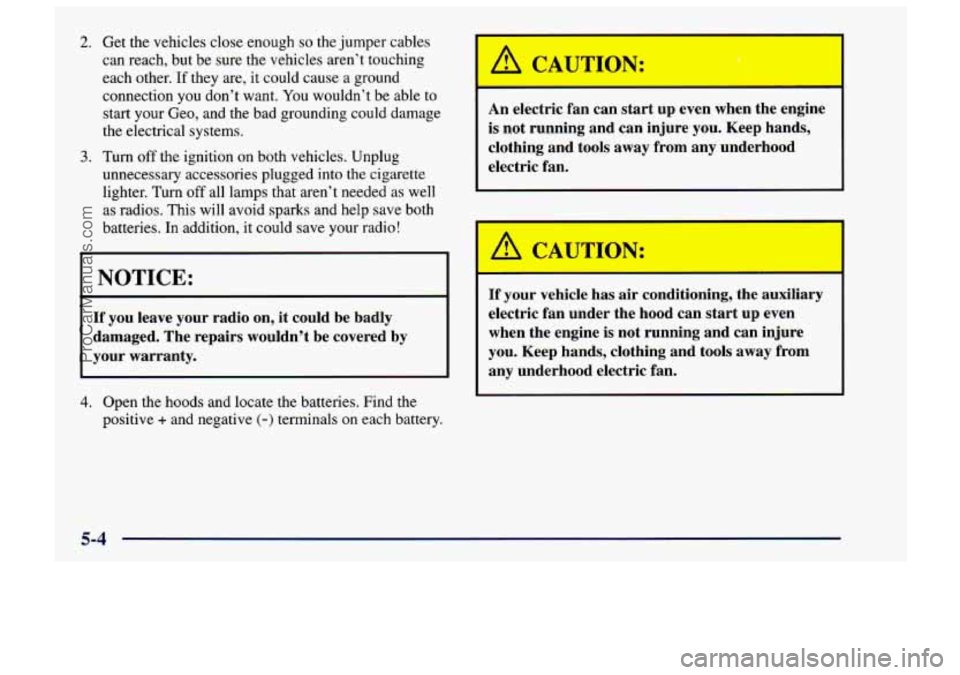
2. Get the vehicles close enough so the jumper cables
can reach, but be sure the vehicles aren’t touching
each other.
If they are, it could cause a ground
connection you don’t want. You wouldn’t be able
to
start your Geo, and the bad grounding could damage
the electrical systems.
3. Turn off the ignition on both vehicles. Unplug
unnecessary accessories plugged into the cigarette
lighter. Turn
off all lamps that aren’t needed as well
as radios. This will avoid sparks and help save both
batteries.
In addition, it could save your radio!
NOTICE:
If you leave your radio on, it could be badly
damaged. The repairs wouldn’t be covered by
your warranty.
4. Open the hoods and locate the batteries. Find the
positive
+ and negative (-) terminals on each battery.
I A CAUTION:
I
An electric fan can start up even when the
is not running and can injure you. Keep hands,
clothing and
tools away from any underhood
electric fan.
-
CAUTION:
If your vehicle has air conditioning, the auxiliary
electric fan under the hood can start
up even
when the engine
is not running and can injure
you. Keep hands, clothing and tools away from
any underhood electric fan.
5-4
ProCarManuals.com
Page 207 of 388
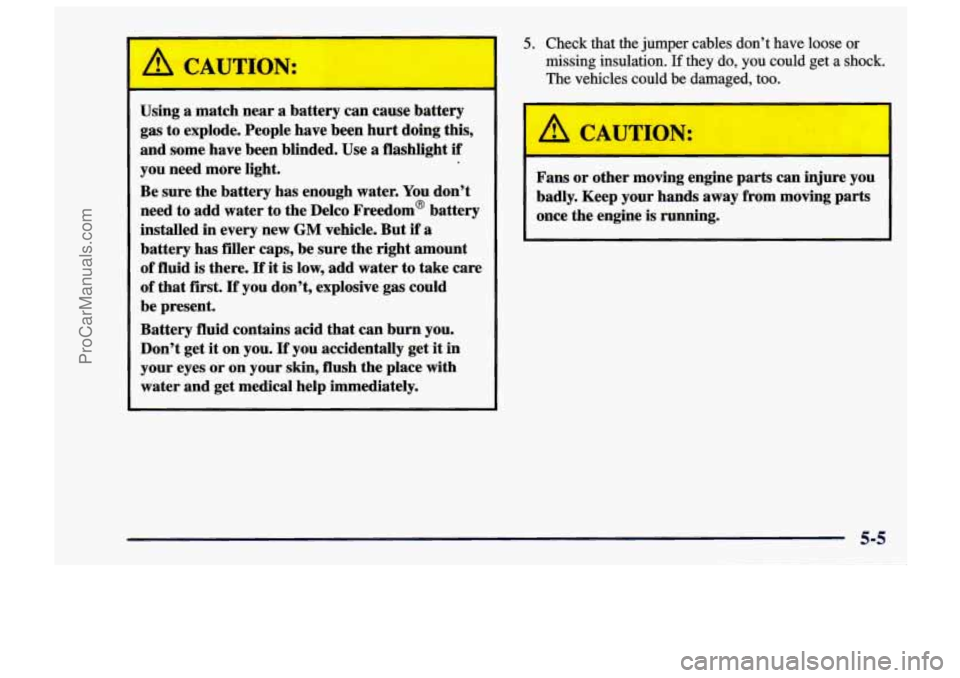
Using a match near a battery can cause battery
gas to explode. People have been hurt doing this,
and some have been blinded. Use a flashlight
if
you need more light.
Be sure the battery has enough water. You don’t
need to add water to the Delco Freedom@ battery
installed in every new
GM vehicle. But if a
battery has filler caps, be sure the right amount
of
fluid is there. If it is low, add water to take care
of that first. If you don’t, explosive gas could
be present.
Battery fluid contains acid that can burn you.
Don’t get
it on you. If you accidentally get it in
your eyes or
on your skin, flush the place with
water and get medical help immediately.
5. Check that the jumper cables don’t have loose or
missing insulation. If they do, you could get a shock.
The vehicles could be damaged, too.
A CAUTION:
-
Fans or other moving engine parts can injure you
badly. Keep your hands away from moving parts
once the engine is running.
5-5
I
ProCarManuals.com
Page 208 of 388
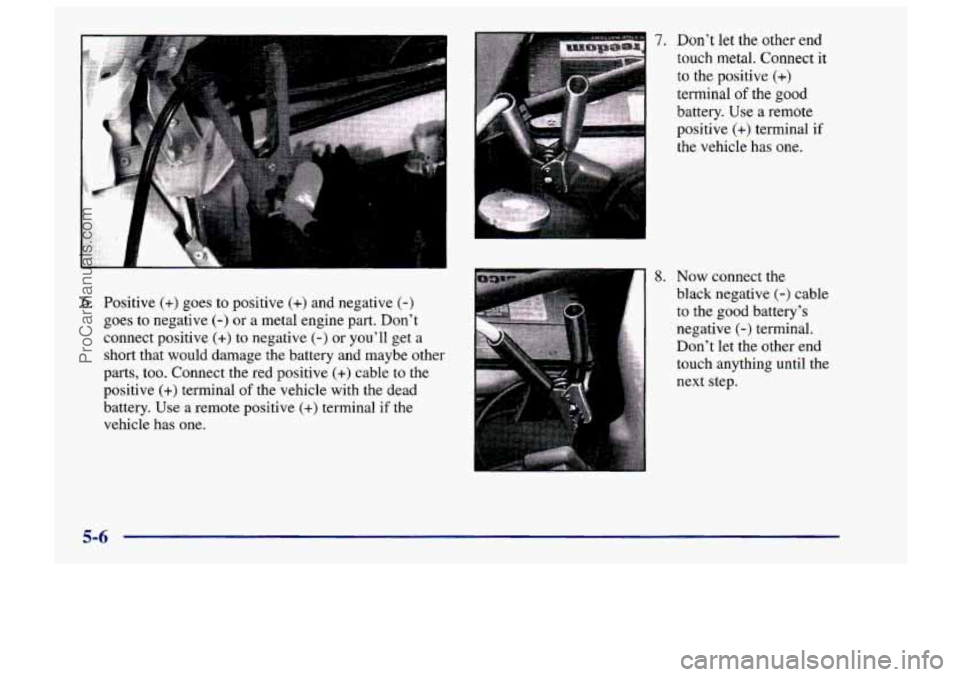
6. Positive (+) goes to positive (+) and negative (-)
goes to negative (-) or a metal engine part. Don’t
connect positive
(+) to negative (-) or you’ll get a
short that would damage the battery and maybe other
parts, too. Connect the red positive
(+) cable to the
positive
(+) terminal of the vehicle with the dead
battery.
Use a remote positive (+) terminal if the
vehicle has one.
1
Don’t let the other end
touch metal. Connect it
to the positive
(+)
terminal of the good
battery. Use a remote
positive
(+) terminal if
the vehicle has one.
8. Now connect the
black negative
(-) cable
to the
good battery’s
negative
(-) terminal.
Don’t let the other end
touch anything until the
next step.
5-6
ProCarManuals.com
Page 209 of 388
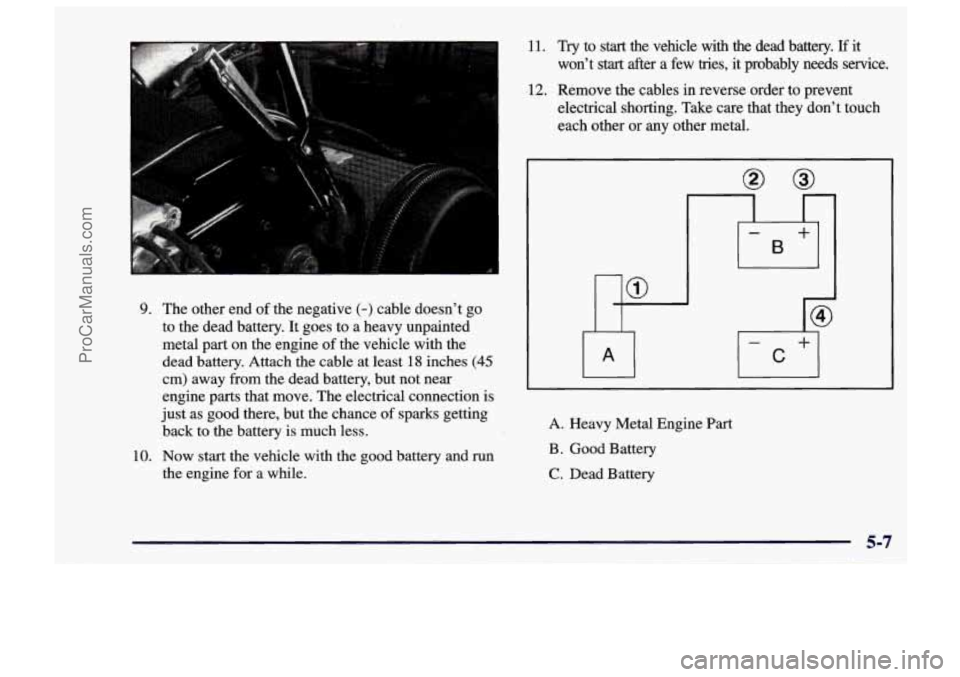
9. The other end of the negative (-) cable doesn’t go
to the dead battery. It goes to a heavy unpainted
metal part on the engine of the vehicle with the
dead battery. Attach the cable at least
18 inches (45
cm) away from the dead battery, but not near
engine parts that move. The electrical connection is
just as good there, but the chance
of sparks getting
back to the battery is much less.
10. Now start the vehicle with the good battery and run
the engine for a while. 11. Try to start the vehicle with
the dead battery. If it
.12. Remove the cables
in reverse order to prevent
won’t
start after
a few tries, it probably needs service.
electrical shorting. Take care that they don’t touch
each other or any other metal.
A. Heavy Metal Engine Part
B. Good Battery
C. Dead Battery
5-7
I
ProCarManuals.com
Page 210 of 388
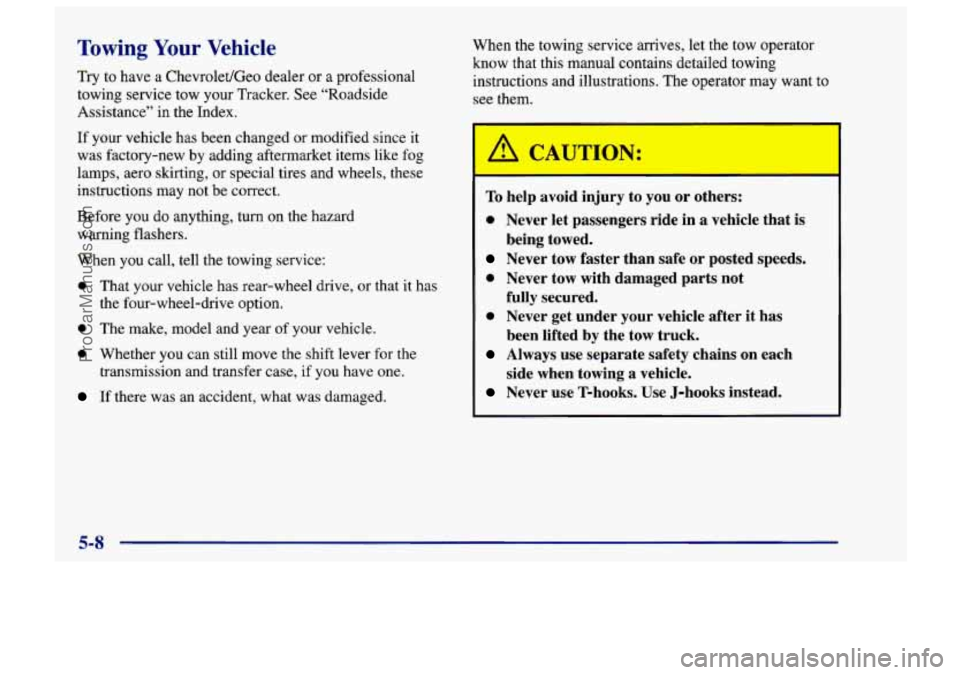
Towing Your Vehicle
Try to have a Chevrolet/Geo dealer or a professional
towing service tow your Tracker. See “Roadside
Assistance” in the Index.
If your vehicle has been changed
or modified since it
was factory-new by adding aftermarket items like fog
lamps, aero skirting,
or special tires and wheels, these
instructions may not be correct.
Before
you do anything, turn on the hazard
warning flashers.
When you call, tell the towing service:
0 That your vehicle has rear-wheel drive, or that it has
0 The make, model and year of your vehicle.
0 Whether you can still move the shift lever for the
transmission and transfer case, if you have one.
the four-wheel-drive option.
If there was
an accident, what was damaged. When the
towing service arrives, let
the tow operator
know that this manual contains detailed towing
instructions and illustrations. The operator may want to
see them.
To help avoid injury to you or others:
0 Never let passengers ride in a vehicle that is
Never tow faster than safe or posted speeds.
0 Never tow with damaged parts not
0 Never get under your vehicle after it has
Always use separate safety chains on each
Never use T-hooks. Use J-hooks instead.
being towed.
fully secured.
been lifted
by the
tow truck.
side when towing a vehicle.
5-8
ProCarManuals.com